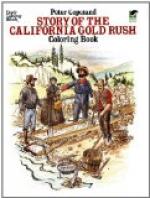The steamship owners, the express and stage companies were all against the railroad, and tried in every way to make people think that an engine could never cross the Sierras. Yet the grading went on, while an army of five thousand men and six hundred horses was at work cutting down trees and hills and filling up the low places. A bridge was built over the American River, and slowly but surely the track climbed the steep mountain-sides. Most of the laborers were Chinese, as white men found mining or farming paid them better.
In ’67 the iron horse had not only climbed the mountains but had reached the state line, and the Union Pacific, which had been laying its tracks over the plains of the Platte River, began to hasten westward. The two railroads were racing to meet each other, and the Central sometimes laid ten miles of rails in one day.
Ogden was made the meeting-point, though at Promontory, fifty miles west of Ogden, the last spike was driven. A thousand people met at that place in May, ’69, to see the short space of track closed and the road finished. A Central train and locomotive from the Pacific came steaming up, and an engine and cars from the Atlantic pulled in on the other side. Both engines whistled till the snow-capped mountains echoed. The last tie was of polished California laurel wood, with a silver plate on which the names of the two companies and their officers were engraved. It was put under the last two rails, and all was fastened together with the last spike. This spike, made of solid gold, Governor Stanford hammered into place with a silver hammer. East and west the news was flashed over the long telegraph line, that the overland railroad had been finished and that two oceans were joined by iron rails.
Now, while flying along in the cars so fast that the trip from Chicago to San Francisco takes but three days, it is hard to believe that little more than thirty years ago travellers in the slow-moving “prairie-schooner” took over five months to cover this same distance.
STORY OF THE WHEAT FIELDS
The Spanish Padres, as the Mission priests were called, taught the Indians to plough and seed with wheat the lands belonging to the church or Mission. They used a simple wooden plough, which oxen pulled. When the warm brown earth was turned up, the Indians broke the clods by dragging great tree branches over them. After the fall rains they scattered tiny wheat kernels and covered them snugly for their nap in the dark ground.
More rain fell, and soon the soaked seeds waked, and started in slender green shoots to find the sunshine, and day by day the stalks grew stronger and the fields greener. Higher and ever higher sprang the wheat, till summer winds set the tall grain waving in a sea of green billows. Have you ever watched the wind blow across a wheat-field? Over and over the long rollers bend the tops of the grain, that rise as the breeze goes on and bend low again at the next breath of wind.




